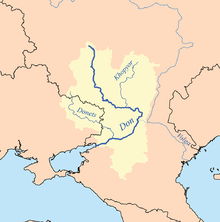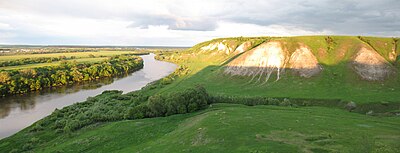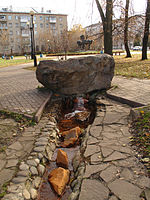Don (river)
| Don | |
|---|---|
 The Don in Voronezh Oblast. | |
 Catchment of the Don | |
| Native name | Дон (Russian) |
| Location | |
| Country | |
| Region | |
| Cities | Voronezh, Rostov-on-Don |
| Physical characteristics | |
| Source | |
| • location | Novomoskovsk, Tula Oblast |
| • coordinates | 54°00′43″N 38°16′41″E / 54.01194°N 38.27806°E |
| • elevation | 238 m (781 ft) |
| Mouth | Sea of Azov |
• location | Kagal'nik, Rostov Oblast |
• coordinates | 47°05′11″N 39°14′19″E / 47.08639°N 39.23861°E |
• elevation | 0 m (0 ft) |
| Length | 1,870 km (1,160 mi) |
| Basin size | 425,600 km2 (164,300 sq mi) |
| Discharge | |
| • average | 935 m3/s (33,000 cu ft/s) |
| Basin features | |
| Tributaries | |
| • left | Khopyor |
| • right | Seversky Donets |
The Don (Russian: Дон) is the fifth-longest river in Europe. Flowing from Central Russia to the Sea of Azov in Southern Russia, it is one of Russia's largest rivers and played an important role for traders from the Byzantine Empire.
Its basin is between the Dnieper basin to the west, the lower Volga basin immediately to the east, and the Oka basin (tributary of the Volga) to the north. Native to much of the basin were Slavic nomads.[1]
The Don rises in the town of Novomoskovsk 60 kilometres (37 mi) southeast of Tula (in turn 193 kilometres (120 mi) south of Moscow), and flows 1,870 kilometres to the Sea of Azov. The river's upper half ribbles (meanders subtly) south; however, its lower half consists of a great eastern curve, including Voronezh, making its final stretch, an estuary, run west south-west. The main city on the river is Rostov-on-Don. Its main tributary is the Seversky Donets, centred on the mid-eastern end of Ukraine, thus the other country in the overall basin. To the east of a series of three great ship locks and associated ponds is the 101-kilometre (63 mi) Volga–Don Canal.
History[edit]
The name Don could stem from the Avestan word dānu- ("river, stream").[2] According to the Kurgan hypothesis, the Volga-Don river region was the homeland of the Proto-Indo-Europeans around 4,000 BC. The Don river functioned as a fertile cradle of civilization where the Neolithic farmer culture of the Near East fused with the hunter-gatherer culture of Siberian groups, resulting in the nomadic pastoralism of the Proto-Indo-Europeans.[3] The east Slavic tribe of the Antes inhabited the Don and other areas of Southern and Central Russia.[4][5] The area around the Don was influenced by the Byzantine Empire because the river was important for traders from Byzantium.[6]
In antiquity, the river was viewed as the border between Europe and Asia by some ancient Greek geographers.[7][8][9] In the Book of Jubilees, it is mentioned as being part of the border, beginning with its easternmost point up to its mouth, between the allotments of the sons of Noah, that of Japheth to the north and that of Shem to the south.[10][note 1] During the times of the old Scythians it was known in Greek as the Tanaïs (Τάναϊς) and has been a major trading route ever since. Tanais appears in ancient Greek sources as both the name of the river and of a city on it, situated in the Maeotian marshes.[note 2] Greeks also called the river Iazartes (Ἰαζάρτης).[12] Pliny gives the Scythian name of the Tanais as Silys.[13]
According to an anonymous Greek source, which historically (but not certainly) has been attributed to Plutarch, the Don was home to the legendary Amazons of Greek mythology.[14]
The area around the estuary has been speculated to be the source of the Black Death in the mid-14th century.[15]
While the lower Don was well known to ancient geographers, its middle and upper reaches were not mapped with any accuracy before the gradual conquest of the area by the Tsardom of Russia in the 16th century.[citation needed]
The Don Cossacks, who settled the fertile valley of the river in the 16th and 17th centuries, were named after the river.[16]
The fort of Donkov was founded by the princes of Ryazan in the late 14th century. The fort stood on the left bank of the Don, about 34 kilometres (21 mi) from the modern town of Dankov, until 1568, when it was destroyed by the Crimean Tatars, but was soon restored at a better fortified location. It is shown as Donko in Mercator's Atlas (1596).[17] Donkov was again relocated in 1618, appearing as Donkagorod in Joan Blaeu's map of 1645.[18]
Both Blaeu and Mercator follow the 16th-century cartographic tradition of letting the Don originate in a great lake, labeled Resanskoy ozera by Blaeu. Mercator follows Giacomo Gastaldo (1551) in showing a waterway connecting this lake (by Gastaldo labeled Ioanis Lago, by Mercator Odoium lac. Iwanowo et Jeztoro) to Ryazan and the Oka River. Mercator shows Mtsensk (Msczene) as a great city on this waterway, suggesting a system of canals connecting the Don with the Zusha (Schat) and Upa (Uppa) centered on a settlement Odoium, reported as Odoium lacum (Juanow ozero)[19] in the map made by Baron Augustin von Mayerberg, leader of an embassy to the Tsardom of Russia in 1661.
In modern literature, the Don region was featured in the work And Quiet Flows the Don by Mikhail Aleksandrovich Sholokhov, a Nobel-prize winning writer from the stanitsa of Veshenskaya.[20]
Dams and canals[edit]
At its easternmost point, the Don comes within 100 kilometres (62 mi) of the Volga. The Volga–Don Canal, 101 kilometres (65 mi), connects the two. It is a broad, deep waterway capable of transporting oil tanker size vessels. It is one of two which enables ships to depart the Caspian Sea, the other, a series, connected to the Baltic Sea. The level of the Don where connected is raised by the Tsimlyansk Dam, forming the Tsimlyansk Reservoir.

For the next 130 kilometres (81 mi) below the Tsimlyansk Dam, the sufficient depth of the Don is maintained by the sequence of three dam-and-ship-lock complexes: the Nikolayevsky Ship Lock (Николаевский гидроузел), Konstantinovsk Ship Lock (Константиновский гидроузел), and the best known of the three, the Kochetovsky Ship Lock (Кочетовский гидроузел). The Kochetovsky Lock, built in 1914–19 and doubled in 2004–08, is 7.5 kilometres (4.7 mi) downstream of the discharge of the Seversky Donets and 131 kilometres (81 mi) upstream of Rostov-on-Don. It is at 47°34′07″N 40°51′10″E / 47.56861°N 40.85278°E. This facility, with its dam, maintains a navigable head of water locally and into the lowermost stretch of the Seversky Donets. This is presently the last lock on the Don; below it, deep-draught navigation is maintained by dredging.[21]
In order to improve shipping conditions in the lower reaches of the Don, the waterway authorities support plans for one or two more low dams with locks. These will be in Bagayevsky District and possibly Aksaysky District.[22]
Tributaries[edit]

Main tributaries from source to mouth:
- Nepryadva
- Krasivaya Mecha
- Bystraya Sosna
- Veduga
- Voronezh
- Tikhaya Sosna
- Bityug
- Osered
- Chyornaya Kalitva
- Khopyor – 1,010 kilometres (630 mi)
- Medveditsa
- Ilovlya
- Chir
- Seversky Donets – 1,053 kilometres (654 mi)
- Aidar – 264 kilometres (164 mi)
- Sal
- Manych
- Aksay
- Temernik
See also[edit]
Footnotes[edit]
Explanatory[edit]
- ^ Later works, as the 7th-century T and O map, also depicts the Don as the border between Europe and Asia
- ^ e.g. Strabo, Geographica[11]
Citations[edit]
- ^ Basilevsky 2016.
- ^ Vasmer 1950, p.362: "Die Quelle ist avest. dānu- f. Fluß, Strom"
- ^ Piazza & Cavalli-Sforza 2006.
- ^ Yilmaz 2015, p. 228.
- ^ Hamilton 1983, p. 2: "During the eighth and ninth centuries the Khazar state reached its greatest extent and power, and the Antes and Slavs of the lower Don and Azov region, the old As or Rus tribes, participated in the first of the empires to be established on Russian soil."
- ^ Tellier 2009, p. 251: "In 1261, the Genoese concluded an alliance with the Byzantine Empire of Nicaea and succeeded to establish trading posts at two terminals of the Silk Road on the Black Sea: Kaffa, in Crimea, and Tana, on the Don River, which runs towards the Black Sea."
- ^ Davies 1996, p.8.
- ^ Jones 1924, p. 183: "Asia is adjacent to Europe, bordering thereon along the Tanaïs River."
- ^ Jones 1924, p. 185: "...Tanaïs River, which I have taken as the boundary between Europe and Asia."
- ^ Jubilees.
- ^ Jones 1924, p. 191: "On the river and the lake is an inhabited city bearing the same name, Tanaïs."
- ^ Suda.
- ^ Rackham 1952, section 20.
- ^ Goodwin 1874, chapter 14.
- ^ Benedictow 2005.
- ^ Chenchevyk 2013.
- ^ Mercator 1595.
- ^ Massa 1645.
- ^ Ostromęcka-Frączak 1976, p. 108.
- ^ Litus 2003.
- ^ Waterway Administration 2012.
- ^ Sea News 2013.
References[edit]
- Basilevsky, Alexander (2016-03-23). Early Ukraine: A Military and Social History to the Mid-19th Century. Jefferson, NC: McFarland & Company. ISBN 978-0-7864-9714-0. OCLC 898167561.
- Vasmer, Max (1950). Russisches etymologisches Wörterbuch [Etymological Dictionary of the Russian Language] (in German). Heidelberg: Carl Winter.
- Piazza, Alberto; Cavalli-Sforza, Luigi (2006). Cangelosi, Angelo; Smith, Andrew D. M.; Smith, Kenny (eds.). "Diffusion of Genes and Languages in Human Evolution" (PDF). The Evolution of Language. New Jersey, London, Singapore: 255–266. doi:10.1142/9789812774262_0033.
- Yilmaz, Harun (2015-02-20). National Identities in Soviet Historiography: The Rise of Nations under Stalin. New York: Routledge. ISBN 9781317596639.
- Hamilton, George Heard (1983). The Art and Architecture of Russia (3 ed.). New Heaven, London: Yale University Press. ISBN 0300053274.
- Tellier, Luc-Normand (2009). Urban world history : An Economic and Geographical Perspective. Québec: Presses de l'Université du Québec. ISBN 9782760522091. OCLC 444730453.
- Davies, Norman (1996). Europe: A History. Oxford, New York: Oxford University Press. ISBN 0198201710.
- Jones, Horace Leonard (1924). The Geography of Strabo. Vol. 5. London: Harvard University Press.
- "The Book of Jubilees". Translated by Charles, R. H. London: Society for Promoting Christian Knowledge. 1917.
- "iota, 5". Suda On Line: Byzantine Lexicography.
- Pliny, Natural History. Vol. IX. Translated by Rackham, H. Cambridge, MA: Harvard University Press. 1952.
- Pseudo-Plutarch (1874). Goodwin, William W. (ed.). De Fluviis. Press Of John Wilson and son.
- Benedictow, Ole J. (2005). "The Black Death: The Greatest Catastrophe Ever". www.historytoday.com.
- Chenchevyk, Iryna (2013-09-15). "Ukrains'ke korinnia' dons'kyh kozakiv" Українське коріння донських козаків [Ukrainian Roots of the Don Cossacks]. Ukrainian Kuban (in Ukrainian). Archived from the original on 2013-11-30. Retrieved 2022-05-19.
- Mercator, Gerardus (1595). "Taurica Chresonesus, Nostra aetate Przecopsca et Gazara dicitur". Atlas sive Cosmographicae meditationes de fabrica mvndi et fabricati figvra [Atlas or Cosmographical Meditations upon the Creation of the Universe, and the Universe as Created]. Duisburg – via Wikimedia Commons.
- Massa, Isaac (1645). "Russiæ, vulgo Moscovia, pars australis". In Blaeu, Willem; Blaeu, Joan (eds.). Theatrum Orbis Terrarum, sive Atlas Novus in quo Tabulæ et Descriptiones Omnium Regionum [Theater of the World, or a New Atlas of Maps and Representations of All Regions] – via Wikimedia Commons.
- Ostromęcka-Frączak, Bożena (1976). Siatkowski, Janusz (ed.). Rozwój funkcji czasownikowych prefiksów wy- i iz- w języku rosyjskim w porównaniu z wy- w języku polskim [Development of the Verb Functions of the Prefixes wy- and iz- in Russian Compared to wy- in Polish] (PhD). Studia językoznawcze: streszczenia prac doktorskich (in Polish). Wrocław: Zakład Narodowy im. Ossolinśkich. pp. 91–128.
- Litus, Ludmilla L. (2003). "Mikhail Aleksandrovich Sholokhov (11 May 1905 – 21 February 1984)". In Rydel, Christine (ed.). Russian Prose Writers Between the World Wars. Dictionary of Literary Biography. Vol. 272. Detroit: Gale Group. pp. 383–408. ISBN 0787660167.
- "Navigacionno-gidrograficheskiy ocherk" Навигационно-гидрографический очерк [Navigational and Hydrographic Overview]. Waterway Administration of the Azov and Don Basin (in Russian). Archived from the original on 2012-06-29.
- "Azovo-Donskoy basseyn: Bagaevsky gidrouzel - reshenie dlya Nizhnego Dona" Азово-Донской бассейн: Багаевский гидроузел – решение для Нижнего Дона [The Azov Sea – Don Basin: The Construction of the Bagayevsly Dam is the Solution for the Lower Don]. Sea News (in Russian) (8). 2013. Archived from the original on 2016-04-15.
External links[edit]
- Kropotkin, Peter Alexeivitch; Bealby, John Thomas (1911). . Encyclopædia Britannica. Vol. 8 (11th ed.). pp. 405–406.
